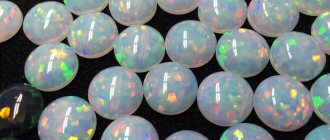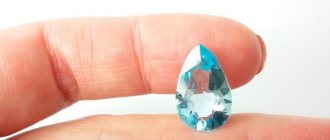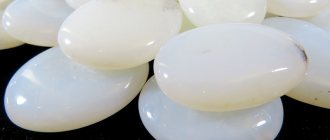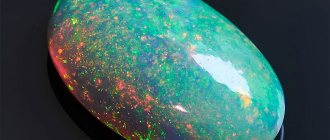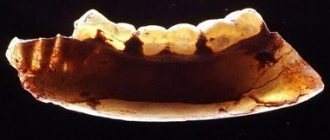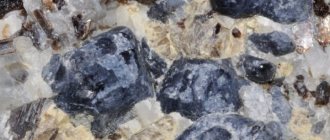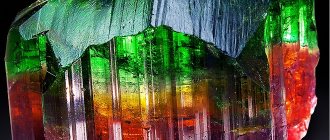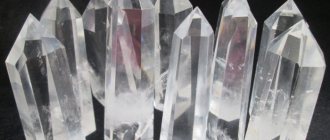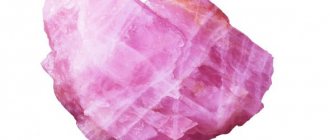Hello, friends! If you have ever seen and held a blue opal in your hands, then you know for sure that this is not an ordinary stone. The original appearance is the first thing that catches your eye. The pebble looks ethereal and mysterious due to its delicate blue base and delicate colored patterns inside. The energy of the mineral is the second thing that attracts attention to it. Even those who are far from esotericism feel the power and magic of blue opal, completely falling under its influence. I suggest delving into the world of stones, learning more about what blue opal is and how, and most importantly, who it helps in life.
Historical reference
The existence and properties of unusual blue pebbles were known in some parts of the world and unknown in others.
For example, opals were brought to Europe from India in the 19th century. Until this moment, besides the Indians, only Australians used the beauty and power of the mineral. Europeans became imbued with the peculiarities of stones and began to actively use them in jewelry to create exquisite jewelry for the “cream” of society.
The cost of blue minerals in rings, necklaces and bracelets exceeded all permissible standards, but not for long. In the mid-20th century, new deposits were discovered. The stones are no longer such a rarity, the price for them has dropped noticeably, although it still remains inaccessible to everyone who wants to enjoy the beauty of opal.
History of the origin of the mineral
The history of this beautiful mineral began back in the days of Ancient India. Local residents admired its shimmer, considering the opal to be magical. At that time, the gem was called jirasol. The beauty of the mineral was also appreciated by the inhabitants of the Australian continent. Stones were brought to Europe from India only in the 19th century. Here they were very popular. Only representatives of the nobility and merchants could afford jewelry with gems.
In the 20th century the stone became known in all corners of the Earth. Gradually, the scale of mineral extraction increased and it became more accessible.
What is blue opal?
Opal is an organic mineral. In addition to water and quartz, it contains silica. You can easily recognize a pebble by its unusual structure. It looks durable, but in practice it is almost as fragile as glass. Interestingly, the largest reserves of blue opal are concentrated near active volcanoes.
A unique feature of the stone is its ability to reflect light, playing with rainbow tints. Opalization is what gemologists call this phenomenon. The stone reveals itself in a yellow gold setting. Its brilliance sets off the inner radiance of the stone, emphasizing its cosmic content. Silver and platinum are also used as cutting options; jewelry with such combinations turns out to be delicate and sophisticated. Blue opal looks beautiful in any type of product, but most often it is chosen for inlay:
- earrings;
- rings;
- pendants;
- pendants, etc.
The water content of opal makes it a special mineral. Fragile and delicate, the pebble requires delicate handling and regular care. The best options are cabochon, oval or circle cuts.
Where is it mined?
The richest deposits of blue opals are in Peru. Interesting rare specimens are mined in several states of America - Nevada and Oregon. Due to the concentration of mineral deposits in Peru, the stone is often called Peruvian. There are samples of both bright neon colors and delicate pastel colors.
There is a beautiful legend about how blue opal became part of the Caribbean Sea. Its waters froze inside the stone forever, reminding each new generation of people of the turquoise tints of sea waves.
Some stones contain inclusions of black and brown colors. These amazing patterns are an imprint of nature inside the stone. Moss, plant elements - all this freezes inside the translucent opal, creating amazing natural patterns.
Until 2003, bluestones were mined exclusively in Peru. The main deposits of the mineral were discovered in Lili and Akari. Today the last mine is no longer operational. Its reserves of opal have been exhausted. Lily is on the verge of exhaustion and will soon close too. This is why specimens of Peruvian pebbles are so highly valued. There are few of them left and soon there will be none left.
Description of the stone
The stone is based on three main substances:
- silica;
- quartz;
- water.
In one gem, the moisture content can reach up to 30%. Blue opal shimmers and glows with all the colors of the rainbow. Gemologists call this effect iridescence.
Only a small part of the mined gem ends up in jewelry because:
- When mined among rocks, blue stones often crack and chip.
- Some specimens cannot be processed and polished, and begin to crumble in the hands of the master.
View this post on Instagram
Posted by Stone Shop (@colourstoneshop) Jan 30, 2021 at 7:13 am PST
Energy and healing properties
The first Peruvian blue opals were discovered in 1983 quite by accident, when they were looking for copper deposits in the south of Lima. Since then, the stone has been considered one of the most beautiful and energetically strong. A recognized relaxant, it helps cope with anxiety, insomnia and anxiety. In a conversation, a pebble creates ease and helps thoughts move freely and in the right direction. Many believe that blue opal gives confidence and instills courage in its owner, and also defeats chronic fatigue, solves problems with brain disorders and gastrointestinal tract function.
Peruvians are convinced that it was no coincidence that blue opal appeared on Earth. The stone is considered a gift from the Incan goddess Pachamama. In Latin America it was called “the stone of faith and hope.” The ancient Indians believed that the meaning of life was in harmony with one’s “I” and the surrounding world. Blue opal helped them achieve the desired state.
What types of imitations are there?
Due to dwindling natural reserves, genuine blue opals are becoming increasingly difficult to purchase. The market is filled with synthetic analogues, which jewelers are happy to use for inlaying products, and not always in good faith indicating a replacement.
Counterfeits of stones are even sold at online auctions, mainly offering analogues from China and India. Most often these are colored agates that are inferior in price.
It is not difficult to distinguish them from natural opal. The first thing that catches your eye is the coloring. For a fake it is uneven. The second is hardness. For natural opal it ranges from 5.5-6.5 on the Mohs scale. For agate, these figures are several times higher. You can recognize the imitation by its texture. In blue opal it is glassy with a delicate transition to pearl with a high degree of transparency and a whitish color when broken.
Synthesized opals are something else. This is not a fake, but an experiment, a way to give the world beautiful stones that are as close to natural as possible without depleting the planet’s resources. The first synthesized samples appeared in 1974. The author was Pierre Gilson. Its specimens were distinguished from their natural counterparts by their density indicators. The synthesized stones turned out to be more porous, with uneven color, and the inability to glow under the influence of UV rays. In all other respects, synthetic opal was practically no inferior to natural opal.
The largest producers of artificial blue stones are in Japan. Companies produce imitations of minerals with an unusual composition, visually and in properties identical to natural ones.
How to distinguish a fake?
Instead of natural opal, cheap glass imitations are often offered. Serial products are decorated with opal doublets. To do this, opal plates are glued onto glass, obsidian or onyx. Externally, it is difficult to distinguish such a stone from a natural one.
If they try to slip you a piece of glass, the natural properties of real opal will help you avoid falling for the bait:
- Opalescence. The shimmer of natural stone is floating, soft, multi-colored, which cannot be said about the glass replacement with sharp reflections of the same color.
- In sunlight, the natural mineral will show all the colors of the rainbow on the hand, but the substitute will not.
- Air bubbles are sometimes visible inside the fake.
- Try to put the stone against your tongue - the fake will definitely stick to it.
- You can put the stone in colored or simply contaminated water - natural opal will change color.
- Natural minerals do not have a repeating pattern; they are characterized by color zoning.
There is also the possibility of purchasing jewelry with artificial opal. Russia, China, and Japan are leaders in growing minerals in laboratory conditions. In fact, artificial opal is created from substances that are found in natural gems. Growing conditions are also close to natural, only the “ripening” period of the stone is about one and a half years.
A synthetic analogue of stone is endowed with such advantages as increased strength, a variety of shades that often do not exist in nature, low cost, and visual appeal. However, it is worth considering that artificial stone is just a decoration. There can be no talk of any magical or healing properties.
Opals in jewelry
Blue opal is highly valued by jewelers, who consider it ideal for inlay. The best cuts for a stone are oval, round and cabochon. All three options reveal the iridescent brilliance of the mineral. An interesting solution is special opal plates. They cover black glass, ordinary opal or obsidian, thus reducing the cost of the finished product without compromising the aesthetic appearance, and are used in earrings, rings, bracelets and pendants.
To give the stone the hardness necessary for processing and use, jewelers place it in an additional setting coated with artificial resin or a layer of oil (this was the case several decades ago).
Light metals, such as white gold, silver and platinum, harmonize with blue opal.
Magic properties
Natural stones are believed to have special magic. Blue opal is no exception. Properties are attributed to him:
- make people balanced and peaceful;
- give happiness and hope;
- help improve everyday life, improve family relationships and warm up love.
The Greeks had an interesting opinion. They believe that blue opal can awaken clairvoyance abilities in everyone.
Another interesting opinion is that the blue mineral is a stone that fills the soul with empty hopes, both good and not so good. The Indians even have their own legend about this. In it, a simple Indian boy found a ring with a blue opal, saw its glow in the dark, and heard screams coming from the stone. The boy showed the stone to a local magician, who advised him to get rid of the find as quickly as possible.
The magician told the guy that the screams coming from the stone were all the evil of humanity that the stone had managed to absorb during its existence. The boy did not take the magician’s words seriously and left the stone with him. The result is sad. From being kind and understanding, he became angry, closed and cruel. Soon the boy with the opal went crazy and went to live in the jungle with the curses of the entire human race.
Whether to believe in the negative impact of a pebble on the owner’s life or to hope for its positive energy is something everyone decides for themselves. In contrast to the legend of the Indian boy, there is a bright tale about how, for many centuries, a stone has been considered a connecting link between man and heavenly forces.
White magicians believe in the ability of blue opal to protect against adversity, awaken intuition, and open doors to the astral world. The blue mineral is saturated with water energy and is associated with the throat and third eye chakras. Anyone who often speaks in public, feels insecure in society and needs to strengthen their authority should have it with them.
Opals in lithotherapy
Not only the Peruvians believed in the healing properties of blue opal. Modern lithotherapists do not doubt its power to heal. They are convinced that the pebble helps to cope with diseases of the nervous system, stabilizes blood pressure and the functioning of the heart muscle.
Owners of blue opals are less likely to fall into a state of depression, feel cheerful and happy, and almost never get colds. In addition, a pebble in a ring or pendant helps normalize vision and improve the functioning of the digestive system. Women in some countries wear a stone on themselves when they want to be cured of infertility.
Who is the stone suitable for?
Blue opal has the amazing ability to adapt to the energy of representatives of all zodiac signs. However, before choosing a mineral as your faithful life partner, it is worth considering how it interacts with each of the signs individually.
- Opal goes well with Libra, helping them make the right decisions. The pebble teaches Capricorns calmness, and Virgos - gentleness and compromise. For Sagittarius, it is better to replace blue opal with fire opal. With its help, Scorpios will be able to protect themselves from ill-wishers.
- Blue opal suits Gemini well. The mineral will bring good luck to representatives of this sign, charging them with energy and inspiration. The ideal solution is blue opal for fish. For everyone born under this sign, the mineral will improve their intuition, double their energy, and teach them to be calm, balanced and kind. Blue opal will help Leos cope with permanent emotional stress, promote the development of loyalty and flexibility, and make Taurus representatives calm and patient.
- An interesting option is blue opal for Cancers. For everyone born under this sign, the pebble will help them become self-confident, calm, get rid of fears and anxieties, and develop intuition.
It is believed that blue opal attracts wealth, helps improve relationships in the family, stabilizes the energy of Cancers and gives them a sense of peace.
What interesting things do you know about blue opal? Have you already felt its effect and can you imagine how to subjugate the energy of the mineral? Share the photo and article with your friends on social networks!
Team LyubiKamni
Which zodiac sign is opal suitable for?
From an astrological point of view, the magic stone is contradictory and multifaceted. Its properties and compatibility with a certain zodiac sign depend on the color of the mineral. Shades of red are suitable for fire signs Leo, Sagittarius, Aries, who have emotional natures, or if the zodiac has a strong-willed character. The Scorpio sign prefers opals of fiery shades. Black gems are compatible with earth signs Taurus, Virgo, Capricorn.
Magic stones with blue and green shades are suitable for air and water signs Gemini Pisces, Libra, Aquarius, Cancer, Scorpio. Green opal helps indecisive Pisces, Libra, Cancer gain confidence, optimism and the missing inner balance. This property is useful for hot-tempered people, who include fire horoscope signs.
Different colors of a magical gem will help develop and improve the strengths of each sign. For Gemini, the stone will enhance creativity and artistry. Capricorns will add strength and perseverance. Opal is considered a spiritual mineral, of mental aspirations; it is powerless in material aspects. It is suitable for people seeking to improve their inner world.
